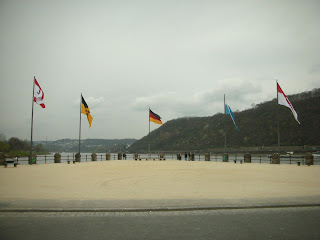Trier (pronounced as 3-er) is at the edge of Germany at the western side near the Luxumberg and the French border. Therefore it is not surprising to see a lot of French students there on excursions. It is one of Germany oldest cities, well it maintains that is the oldest, and this is contested by Worms, which also claims that they are the oldest cities. The day spent in Trier was like a day spent in little Rome, because it much of the structures seem to give me the impression that I was in Rome, although the intensity was definitely not as much. I have never been to Rome before and I am really looking forward to it in June. Hence Trier is like a preview of what I can probably expect in Rome.
Indeed, a check after the trip revealed that Trier was founded by the Romans in the 15th century BC, and its collection of Roman monuments and structures led it to accquire the UNESCO World Heritage Site status in 1986.
 The Porta Niga, which is the Latin equivalent for black gate, was built in the 2nd century. The pillar was purely iron rods. Resembles a corner of the Colosseum in Rome? I will do a comparison after I have been to Rome.
The Porta Niga, which is the Latin equivalent for black gate, was built in the 2nd century. The pillar was purely iron rods. Resembles a corner of the Colosseum in Rome? I will do a comparison after I have been to Rome.
 The Hauptmarkt (main Market), a marketplace which has a square which was lined up with beautifully painted houses. There was an interesting movement, or demonstration when I was there. It was a movement to encourage people to go vegetarian and stop eating meat. What happened was that the demonstrators, who were all ladies, stripped to their panties and bras and with their skin dripping with red paint, to imitate blood, they went around giving leaflets and explaining to their people about their movement. Not surprisingly, it attracted alot of attention.
The Hauptmarkt (main Market), a marketplace which has a square which was lined up with beautifully painted houses. There was an interesting movement, or demonstration when I was there. It was a movement to encourage people to go vegetarian and stop eating meat. What happened was that the demonstrators, who were all ladies, stripped to their panties and bras and with their skin dripping with red paint, to imitate blood, they went around giving leaflets and explaining to their people about their movement. Not surprisingly, it attracted alot of attention.  The Dom, which looked more like a fortress than a cathedral
The Dom, which looked more like a fortress than a cathedral Below: one of the most priceless monuments in the Dome.
Below: one of the most priceless monuments in the Dome.
 Kaiserthermen - This was once an imperial thermal bathing complex. This ruined structure you see is part of the section of the hot pool area.
Kaiserthermen - This was once an imperial thermal bathing complex. This ruined structure you see is part of the section of the hot pool area.
 The Amphitheater - the place where gladiators won and died. It had a capacity that was once able to hold 20,000 people during matches. If you look at the stage at the picture above, you can see two small stairs that lead to the basement cellar.
The Amphitheater - the place where gladiators won and died. It had a capacity that was once able to hold 20,000 people during matches. If you look at the stage at the picture above, you can see two small stairs that lead to the basement cellar.
 And this is how the cellar looks like in the basement. It was a once used to keep caged animals, prisoners as well as corpses.
And this is how the cellar looks like in the basement. It was a once used to keep caged animals, prisoners as well as corpses. Das Karl-Marx Haus: Karl Marx the father of communism, was born in Trier in the very house above. It was quite surprising to hear that because to me, Marx is very much associated with Berlin and Jena, where he came up with most of his revolutionary ideals.
Das Karl-Marx Haus: Karl Marx the father of communism, was born in Trier in the very house above. It was quite surprising to hear that because to me, Marx is very much associated with Berlin and Jena, where he came up with most of his revolutionary ideals.

Am Plan, this is a square that used to be a place for public executions.
 This crossroad of the main shopping street, the Löhrstraße, is called the 4 towers. It is a pretty intersection where the corner of 4 17th century buildings face other.
This crossroad of the main shopping street, the Löhrstraße, is called the 4 towers. It is a pretty intersection where the corner of 4 17th century buildings face other. 



No comments:
Post a Comment